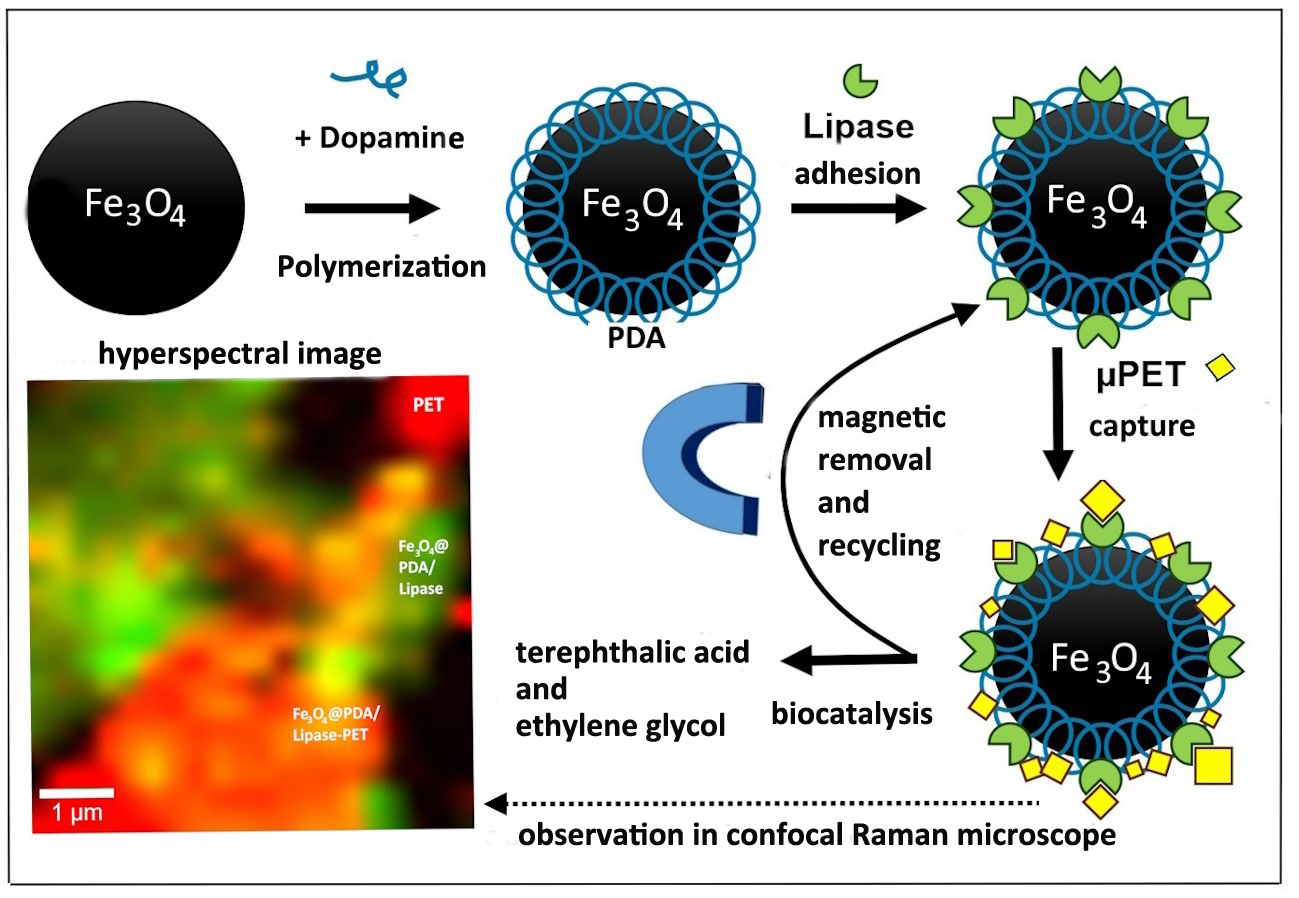


Summary of purification process: water polluted by microplastics (PET); addition of magnetic nanoparticles functionalized with polydopamine and lipase; removal of nanoparticles with microplastics using a magnet (photos: Henrique Eisi Toma)
Published on 11/11/2024
By José Tadeu Arantes | Agência FAPESP – Researchers at the University of São Paulo (USP) in Brazil have developed a novel nanotechnology-based solution for the removal of micro- and nanoplastics from water. An article on the research, which was supported by FAPESP, is published in the journal Micron.
Tiny plastic particles are ubiquitous in the world today and may currently be one of the most important environmental problems, after the climate emergency and the accelerating extinction of species and ecosystems. Microplastics are in the soil, water and air, and in the bodies of animals and humans. They come from everyday consumer goods and from wear-and-tear on larger materials. They are found everywhere and in every kind of environment. A major source is the water used to wash clothes made of synthetic fibers. Microplastics currently cannot be filtered out of wastewater and eventually penetrate the soil, water table, rivers, oceans and atmosphere.
Defined as fragments of up to 1 millimeter, microplastics proper are a well-identified and visible problem. Nanoplastics, however, are a thousand times smaller and are proving an even more insidious hazard, since they can pass through key biological barriers and reach vital organs. A recent scientific study, for example, detected their presence in the human brain.
“Nanoparticles aren’t visible to the naked eye or detectable using conventional microscopes, so they’re very hard to identify and remove from water treatment systems,” said Henrique Eisi Toma, a professor at the Institute of Chemistry (IQ-USP) and last author of the Micron article.
The procedure developed at USP uses magnetic nanoparticles functionalized with polydopamine, a polymer derived from dopamine, a neurotransmitter present in the human organism. These nanoparticles can bind to micro- and nanoplastics waste, and the combined particles can then be removed from water via application of a magnetic field.
“Polydopamine is a substance that mimics the adhesive properties of mussels, which cling very tenaciously to many surfaces. It adheres firmly to fragments of plastic in water and enables the magnetic nanoparticles to capture them. This undesirable material can then be removed from the water with a magnet,” Toma said.
The process has already been proven effective for removing micro- and nanoplastics from water, especially in treatment systems. However, the research group also aims to degrade them using specific enzymes such as lipase, which can break down polyethylene terephthalate (PET) into its basic components. Application of the enzymes decomposes PET and other widely used plastics into smaller molecules, which can be reused to produce plastic materials. “Our goal isn’t just to remove plastic from water but also to contribute to its recycling in a sustainable manner,” Toma said.
PET is a raw material for plastic bottles and other items. It is a major pollutant, not least because its degradation produces terephthalic acid (C6H4(COOH)2) and ethylene glycol (C2H4(OH)2), both of which are toxic. “Lipase breaks down PET into these initial monomeric forms, which can be reused to synthesize new PETs. Our study focused on PET, but other researchers can include other specific enzymes to process different plastics, such as polyamide or nylon, for example,” he said.
In the study led by Toma, magnetic nanoparticles of iron (II, III) oxide, or black iron oxide (Fe₃O₄), were synthesized by co-precipitation and later coated with polydopamine (PDA) by partially oxidizing dopamine in a mildly alkaline solution to form Fe₃O₄@PDA. Lipase was immobilized on this substrate. Hyperspectral Raman microscopy was used to monitor sequestration and degradation of the plastic in real time.

The sequence shows capture, removal and imaging of pollutants (credit: Henrique Eisi Toma)
Complex problem
The term “plastics” refers to a wide array of synthetic or semi-synthetic polymers, most of which are derived from fossil fuels. Their malleability, flexibility, light weight, durability and low cost have assured their presence in countless products used in everyday life. Concerns regarding the residues and waste produced by this highly intensive use have led to a search for alternatives, such as bioplastics. Instead of nonrenewable petrochemicals, bioplastics are derived from renewable and biodegradable sources.
“It’s a good idea, but before they fully degrade, bioplastics also fragment and form micro- or nanoplastics. Being biocompatible, they’re even more insidious because they can interact more directly with our organisms and trigger biological reactions,” Toma said.
Another troubling piece of information provided by Toma is that bottled mineral water may be even more contaminated by bioplastics than the treated potable water we consume in our homes. “Treated potable water undergoes processes such as filtration, coagulation and flotation to eliminate most residues, whereas mineral water, which is better in some ways – it’s lighter, contains more salts and tastes better, for example – isn’t processed in any of these ways because that would destroy its properties. If the environment from which it’s collected is contaminated by bioplastics, these particles will reach the consumer,” he said.
In sum, the challenge is daunting and there are no obvious answers. The nanotechnology presented by Toma and collaborators offers a promising solution to a problem whose full extent is only just starting to be understood. He urges other researchers to persist in the search for solutions and appeals to public administrators to take the problem seriously.
The article “Direct monitoring of the enzymatic sequestering and degrading of PET microplastics using hyperspectral Raman microscopy” is at: www.sciencedirect.com/science/article/abs/pii/S0968432824001392?via%3Dihub.
Source: https://agencia.fapesp.br/53275